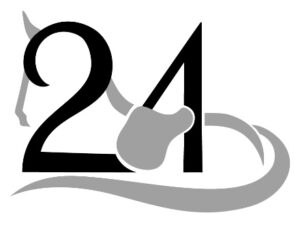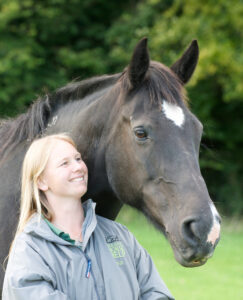A Guest Blog by Dr Sue Dyson
Contact sue.dyson@aol.com

In October 2022 I spoke at a meeting held in conjunction with the Lyon international horse show in France. My topic was the use of the Ridden Horse Pain Ethogram, otherwise known as the Ridden Horse Performance Check List, for early recognition of musculoskeletal pain. Alternatively, I could say that I was promoting the concept that comfortable horses are ‘happy’ athletes and providing evidence that they are likely to perform better than horses experiencing discomfort. I also had the opportunity to spend several hours watching the warm-up arena for the showjumping competitions and was struck by a number of observations, some of which I will discuss.
Firstly, the practice of Rollkur was quite common. This ‘schooling’ method is strictly policed by the FEI stewards in dressage warm-up arenas, but did not appear to be controlled in any way. There is little scientifically based information that Rollkur is physically damaging for horses, although inevitably it results in a degree of airway constriction. The horse below, with the white of the eye exposed, the mouth widely open and tilting of the head, is likely experiencing at least some stress.
Secondly, I observed several horses which were dismounted in order to reposition the saddle further forwards – too far forwards – with the potential of the saddle to restrict movement of the scapulae. With the saddle below, which has just been deliberately moved forwards, the seat tipped backwards, encouraging the ridder to sit further back, potentially overloading the caudal third of the saddle. A saddle which is positioned so far forwards will inevitably slide back to some extent during ridden exercise. Why do show jumpers feel the need to position a saddle too far forwards? Forces under the front half of the saddle rise markedly when landing from a jump. There are cartilaginous extensions on the top end of each scapula (shoulder blade) and these and the overlying muscles are at risk of injury with a saddle positioned too far forwards.
Thirdly I observed a variety of different adaptations to take-off, the jump and landing. A number of riders rotated their bodies on take-off so that their weight distribution was not symmetrical. We cannot say with certainty that this will compromise performance in the short term, but repeated asymmetrical loading will inevitably be detrimental to a horse and ultimately result in adverse effects on performance. I wonder how many riders are truly aware of their position over a fence and how influential this might be.
A normal horse should push off the hindlimbs symmetrically, so that the trunk remains perpendicular to the fence during the jump. Some horses pushed off the hindlimbs asymmetrically so that the hindlimbs and trunk rotate during the jump phase. Asymmetrical push off is usually secondary to hindlimb discomfort – the horse pushes off less strongly with the limb that is uncomfortable. With repeated jumps the effect may be magnified, with the potential for the horse to make errors.
Normal horses land with their ears forwards, usually with the eyes open. Some horses repeatedly landed with the ears back and the eyes closed, likely reflecting forelimb discomfort or less commonly pain associate with the neck being in extension.
A normal horse lands with the forelimbs side by side, separated by the width of the chest, and with the neck and head straight. The horse below is twisting its neck and head to the right and has landed with the forelimbs almost in line, with little front to back separation of the front feet. This is unquestionably an adaptation to share load between the leading and trailing forelimbs, probably to reduce discomfort.
Finally, in the strides immediately after a fence a normal horse takes even length strides in canter, moving fluently forwards. This is clearly not the case in the move-off from the fence in the horse pictured below. The head and neck are raised. The ears are back.
The eyes have an intense stare. The mouth is wide open. The tail is swishing and both hindlimbs are off the ground reflecting a small buck. Bucking ± kicking out after landing over a fence usually reflect a component of lumbosacroiliac region pain.
So what do these observations mean? To me it means that with careful attention to detail there is the potential to improve both comfort and performance and provide a ‘happier’ athlete. Rider position, saddle fit for both horse and rider and the musculoskeletal comfort of the horse are all crucial factors for optimisation of performance. This requires a team approach from a trainer/ coach who focuses on both the horse and the rider, a skilled saddle fitter, an experienced physiotherapist and an equine veterinarian skilled in identification of low-grade lameness and other adaptations of movement which reflect underlying discomfort. Riders have a responsibility to their horses to provide the best for their horses, to be consummate horsemen.
I would also like to draw your attention to the bits, nosebands, martingales and other accessories used on the horses I have discussed in marked contrast to the photograph of Gregory Cottard (France), below – a simple snaffle bit, no noseband, no martingale – competing successfully at 5* level. Gregory commented that with appropriate training and true horsemanship additional tack was not required.
Photograph courtesy of Richard Juilliart FEI
Copyright Sue Dyson, 2023
Keep an eye out for the new book by Sue Palmer and Sue Dyson, “Harmonious Horsemanship: How to use the Ridden Horse Ethogram to Optimise Potential, Partnership, and Performance”. This ground-breaking book is co-authored with Dr Sue Dyson and will be available summer of 2023. Sign up at www.harmonioushorsemanship.co.uk to be kept up to date with new information as it comes available. In the meantime, you can find out more about the Ridden Horse Ethogram here.

Sue Palmer, aka The Horse Physio, is an award-winning ACPAT and RAMP registered Chartered Physiotherapist, an Intelligent Horsemanship Recommended Trainer and holds an MSc. Formerly a competitive rider and BHSAI, she works full-time treating horses. Sue shares her passion for ethical and harmonious horsemanship through multiple courses, books, and articles. Sign up at www.thehorsephysio.co.uk to be the first to hear about new releases.